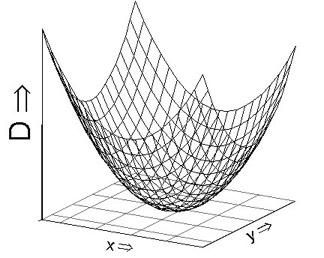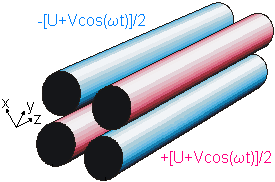If the electric field acting on a charged particle oscillates, the induced force will also oscillate. In the case of an inhomogeneous field, the force averaged over one period is nonzero. This average force can be related to a pseudo-potential, called D.

The resultant motion is essentially the same as what is produced by a parabolic potential. This pseudo-potential can be used to confine ions in a space where they oscillate back and forth. Hence, we can use the pseudo-potential to guide and to trap ions. At LEBIT, RF quadrupole ion guides are used with the ion beam cooler and buncher, and also with the local plasma ion source.


One use for RFQ ion guides is selectinge the correct species to measure, i.e. a mass filter. LEBIT uses a mass filter, whose configuration is shown to the left, in conjunction with the plasma ion source. The ion beam cooler and buncher can also be operated in a mass filtering mode.
First, let's consider each electrode to have a potential of U/2 and each electrode pair to have opposite signs. The quadrupole field in the xy-plane is inversely proportional to the distance from the center squared. The field in the x-direction is negative, and the field in the y-direction is positive. For a constant voltage U, the ions will oscillate in the yz-plane, but their amplitude in the x-direction will grow exponentially until the ion strikes the wall.
If an RF voltage V driven at a frequency omega is added to the DC voltage U, ions may pass quadrupole. To determine this, we must look at the equations of motion. Two unitless parameters, a and q, arise from these differential equations; and, they are functions of distance from center, voltage, mass, and frequency. These parameters determine which masses will pass. For stable motion, the ion oscillates in the xy-plane with limited amplitudes and move in the z-direction. For unstable motion, the amplitudes in the xy-plane increases exponentially, and the ion strikes an electrode.
The ratio a/q equals 2U/V; notice it is independent of mass. So all masses lie along an operating line, along which a/q is constant. For example, on an a-q map, a region of stability stretches along the q-axis from zero to some maximum value of q; then all masses greater than the corresponding minimum mass will pass through the filter. As the DC voltage U is increased, the mass range becomes smaller. If U and V are changed simultaneously and proportionally so that a/q remains constant, each mass is successively brought into the region of stability.
If an RF voltage V driven at a frequency omega is added to the DC voltage U, ions may pass quadrupole. To determine this, we must look at the equations of motion. Two unitless parameters, a and q, arise from these differential equations; and, they are functions of distance from center, voltage, mass, and frequency. These parameters determine which masses will pass. For stable motion, the ion oscillates in the xy-plane with limited amplitudes and move in the z-direction. For unstable motion, the amplitudes in the xy-plane increases exponentially, and the ion strikes an electrode.
The ratio a/q equals 2U/V; notice it is independent of mass. So all masses lie along an operating line, along which a/q is constant. For example, on an a-q map, a region of stability stretches along the q-axis from zero to some maximum value of q; then all masses greater than the corresponding minimum mass will pass through the filter. As the DC voltage U is increased, the mass range becomes smaller. If U and V are changed simultaneously and proportionally so that a/q remains constant, each mass is successively brought into the region of stability.